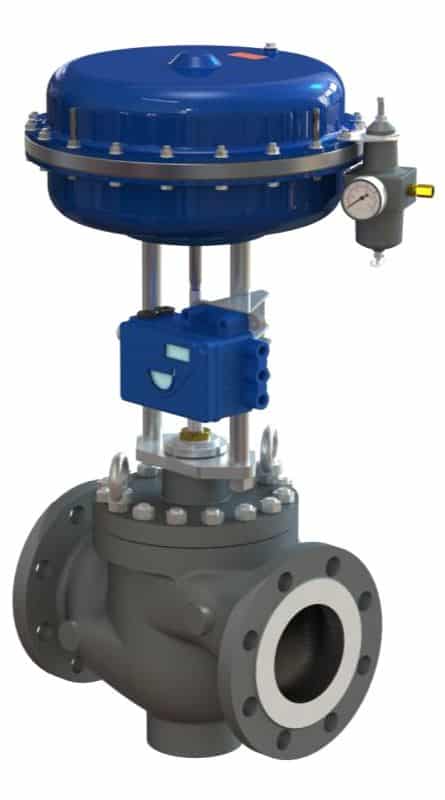Temperature Control Valves
Temperature control valves have a wide variety of uses. They can be used for residential, commercial, industrial, and agricultural purposes. They can also be used in food processing plants and breweries. Essentially, they’re a useful valve when you want to maintain a certain temperature for certain processes. They can be used for heating and cooling and can even help with energy savings.
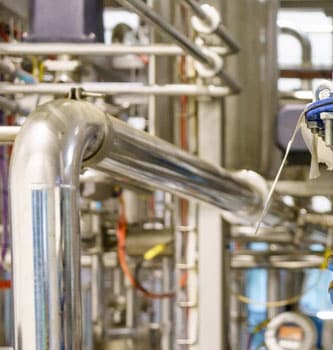
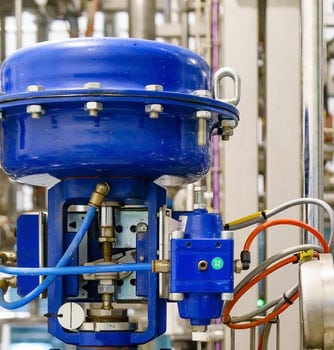
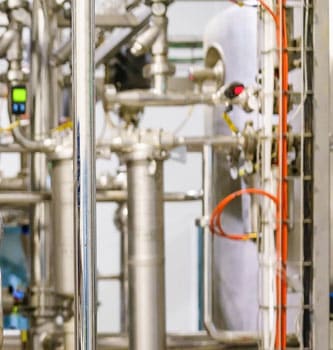
Speak with our experts
Fill out our quick and easy contact form with your enquiry and we'll get back to you.
What Is a Temperature Control Valve (TCV)?
Temperature Control Valves (TCV) are used to control the temperature of a fluid. It is essentially an assembly of two or more valves that controls the flow of liquid or gas through a pipe by opening and closing it at different rates. They are usually installed in a Heating, Ventilation and Air Conditioning (HVAC) system to improve efficiency and reduce energy consumption.
Temperature Control Valves are designed to control the temperature of a process by controlling thermal fluid pressure or flow in boilers, furnaces, hot water tanks, and refrigerators. They can also be found on underground pipelines for natural gas distribution. They’re essentially used in places where temperature needs to be kept stable despite temperature changes in the surrounding environment.
Temperature Control Valves Explained
How Temperature Regulators and Control Valves Work
Temperature Control Valves are used to regulate the temperature in a particular area. They are used in HVAC systems, boilers, industrial processes, and other similar applications. A temperature regulator is an important component of a temperature control valve. It is an integral part of the valve and it is responsible for maintaining the desired temperature range by regulating the flow of hot or cold water through it.
Temperature regulators can be manually operated or electronically operated. They can also be combined with other components such as pressure regulators and flow regulators to achieve precise regulation of pressure and water flow through them.
Thermostatic vs Actuated Valves
There are a number of different types of temperature control valves. These include thermostatic, actuated, electric and pneumatic valves.
Thermostatic valves are the most common type of Temperature Control Valve. They use a sensor to detect the temperature and then open or shut the valve accordingly. The thermostat values for these types of valves typically vary from 0-100 degrees Celsius.
Actuated valves use a motor to open or shut the valve according to its set values from a controller. These values can be set in either degrees celsius or in Fahrenheit, depending on what is needed by the application at hand.
The best solution required often comes down to two options relating to the circumstances in which the valve is being deployed. Is the valve to be placed in a complete system that is controlled by temperature sensors or is it operating as a stand-alone element?
Types of Temperature Control Valve
Thermostatic Control Valves
Thermostatic Control Valves are one of the most important pieces of a central heating system. They are designed to regulate the temperature in a room. Thermostatic Control Valves can save you money by reducing your energy bills and by preventing accidents. They also help to make your home more comfortable as they can adjust the temperature in rooms based on what is needed.
Once the thermostatic element is installed, you may calibrate it to ensure that it's operating reliably. This prevents operators from inadvertently running the equipment at temperatures that are too hot or cold which could then result in higher fuel consumption.
Actuated Control Valves
Actuated Control Valves are used in many industrial applications. They are used as a safety device that reduces the risk of flooding or other hazardous conditions. Actuated Control Valves are typically made of steel and have a valve stem that is actuated by a hydraulic actuator. They can be operated manually or they can be run automatically by an electronic controller.
They have been designed to be user-friendly, with the valve stem and actuator being easily accessible for maintenance and repairs. The probe sends a signal to a control panel to open or close the valve ports using an external power source.
Pneumatic Control Valves for Temperature Control
Pneumatic Control Valves are used for temperature control in the industry. Pneumatic control valves are a type of valve that is used to control various fluids throughout many applications in industry, they are used extensively in a processing plant where a speed of response and high levels of accurate control is required.
They will generally have an electro- pneumatic positioner which will be given a 4 – 20 mA signal to govern the amount of compressed air that is fed to the pneumatic actuator, in order for it to extend or retract a stem and plug to govern the heating or cooling media.
Electric Control Valves for Temperature Control
An Electric Control Valve is an electrical device that controls the flow of a fluid. It is used to regulate the temperature in a process by controlling the flow of hot and cold water, steam, or other fluids. Electric Control Valves are used in many industries and can be found in residential, commercial, industrial and institutional buildings. They are also used to help with temperature control in both domestic and commercial applications.
The use of Electric Control Valves has increased significantly over time as they have become more cost-effective than traditional methods of temperature regulation such as heating or cooling systems.
Valveforce Temperature Control Valves
Self-Acting Thermostatic Valves
The thermostatic temperature controller, which consists of a thermostat and a temperature control valve, is used for controlling temperatures in central heating, district heating systems, industrial plants or marine systems. It can be used for the control of cold or hot water, steam or oil, in heating or cooling systems.
A thermostat consists of a sensor and a capillary tube filled with liquid and an adjusting cylinder. The thermostat is self-acting and based on the principle of liquid expansion. It has a sturdy design and operates with a large closing force. The adjusting cylinder of the thermostat is set at the required temperature for the heated medium in °C.
The temperature control is carried out by the thermostatically controlled temperature control valve reducing or increasing the flow of the heating (or cooling) medium.
If the temperature of the medium to be heated is above the required level, the sensor liquid expands causing the piston of the thermostat to act upon the automatic temperature control valve, reducing the flow of the heating medium. If the temperature of the medium to be heated is below the required level, the temperature of the sensor liquid falls, reducing the volume of the liquid so that the piston allows the automatic temperature control valve to open under its internal spring, thus increasing the flow of the heating medium.
- Our range is suitable for steam, water and thermal oil processes
- Direct-acting valves for heating applications
- Reverse-acting valves for cooling processes
- Bellows an piston balanced valves allow for larger self-acting valves with shut off against higher pressure
- 3-way valves for diverting/ mixing
- Quick acting via fluid expansion in the valve thermostat
- Low demand DHW heating
- Low demand steam injection
- Blowdown vessel cooling
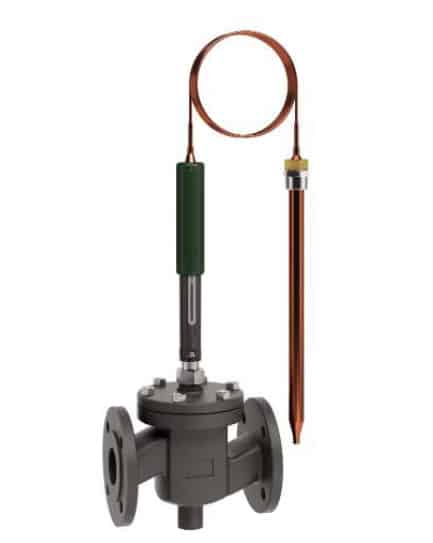
Electric Control Valves for Temperature Control
- For applications where electric actuation is necessary we have fast acting electric actuators
- Suitable for processes such as DHW heating
- Our actuation speeds ensure processes won’t overheat
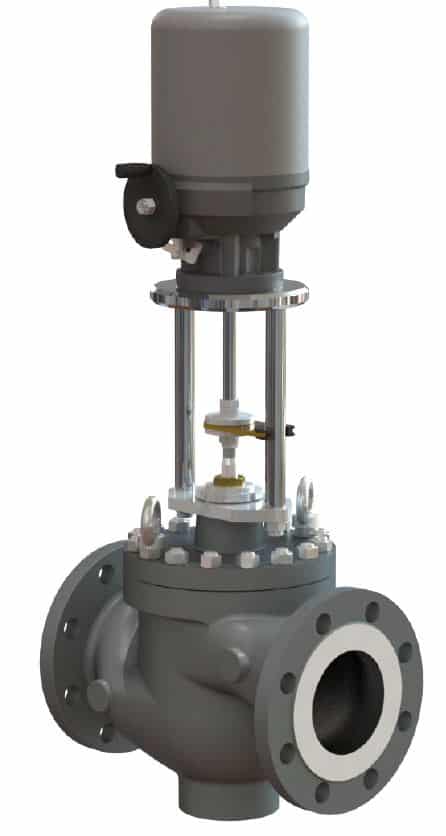
Pneumatic Control Valves for Temperature Control
- The first choice for temperature control for larger processes
- Instantaneous response via pneumatic control
- Ideal for processes such as DHW heating
- Steam injection
- Fitted with electro pneumatic positioners tailored to meet requirements such as Profibus protocols and Atex environments
